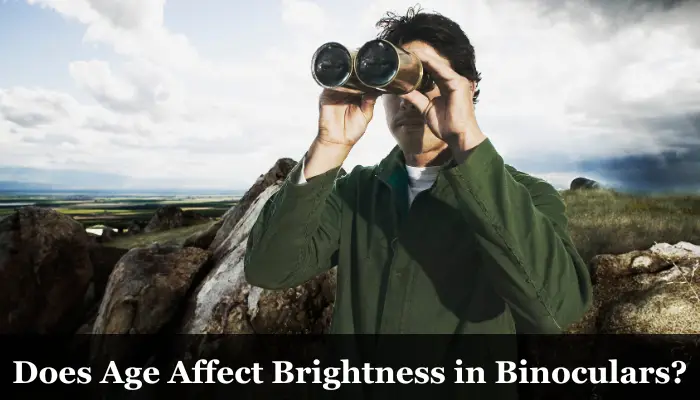This post may contain affiliate links which means I may receive a small commission for purchases made through the links. Learn More
People of different ages use binoculars for their outdoor adventurers. But one thing that I have noticed is that the elderly usually complain that their newly bought binos do not produce sharp and brighter visuals.
That brings a question: Does age affect the image brightness in binoculars? Yes, the age of a person has a big impact on how bright an image you perceive. Elderly people will see less brightness due to the fact that the pupil size of their eyes does not dilate to an optimal level.
Keep in mind that by using suitable binos, you can always tackle this issue of compromised dilation of the exit pupil of the eyes. Let’s drill down and learn more about this topic.
Related Article: Is the Objective Lens of a Binocular Convex or Concave?
Does age Impact the Perception of Image Brightness in Binoculars?
Yes, the age of the user does play an important role in the image brightness when using binoculars. The impact is more obvious when you use the binoculars in low light conditions. Old people have small pupil size, which does not capture enough incoming light. As a result, older people see dim visuals when using the binos.
It is important to understand the size of the pupil which is the most important thing to understand how age impacts the performance of the binos you use. A human eye dilates between 5mm to 9mm. But when you get old, your pupil does not dilate efficiently.
Your maximum pupil dilation goes down to 5 mm which is compromised dilation when you are using the binoculars. There is one other thing which you should understand. That is the exit pupil of the binoculars.
The exit pupil of the binoculars must be equal to or bigger than the size of your pupil. Right? If the exit pupil of binos is bigger, you will get a brighter image.
But if the exit pupil is smaller than the pupil size of your eyes then you will observe dom visuals.
So, when you are old, your pupil dilation size goes down to 4 mm, and the binoculars you usually use consist of 5mm or 6mm. In this case, you will see a less bright image. Light leaving the binos won’t be able to reach your eyes, and you will see dim visuals.
But, I know, you are still confused! Don’t worry, my goal is to make things super simple for you so that understanding gets easier. Let me explain the exit pupil of the binos and then its relation with the pupil size of your eyes.
Exit Pupil of Binoculars
The exit pupil is the point or place where the light leaves the binoculars. It is present on the eyepiece of the binoculars. The bigger the exit pupil, more brighter, and sharper the visuals you will see. The reason is that more light will be able to reach your eyes.
Those binoculars which have a bigger exit pupil perform better in lowlight conditions. But you’ll be getting confused, about how to know the exact exit pupil of any binoculars. Actually, there is a simple formula which is as follows:
Exit Pupil (mm)= Objective Lens Diameter / Magnification power
By dividing the size of the objective lens, by the magnification power, you will come to know the exact exit pupil size of any binoculars. Suppose you have 10×50 binoculars. It has 10x magnification, and 50mm of objective lens size, then by these values, you’ll be able to know the exit pupil size of your binos.
Exit Pupil = 50 / 10 = 5 mm
Now, no matter what kind of binoculars you have, or what specification your binos have, by following this simple method you can easily calculate the exit pupil size of the binos that is usually measured in millimeters. You can also find more details about exit pupils here.
So, if you know the exact pupil of the binos, it is time to understand the relation between the human pupil size, and the exit pupil of binoculars. It would help you understand the topic in more detail.
Relation between pupil size and exit pupil size
As I said earlier, the pupil size of human eyes ranges between 5mm to 9mm. But when you grow older, your pupil size decreases. You cannot dilate the pupil to its normal size like 8 mm or so. Instead, you end up getting a full pupil dilation size of 5 mm or even less than that.
If you are using 10×30 binos, it means that the exit pupil size of those binos will be 3mm. Suppose you are an old person who has a reduced pupil size of 5mm, then with those binos, you won’t get brighter visuals because a lot of light will get wasted.
If you are an old person, you should always make sure that you choose the binos with a bigger-sized exit pupil (Bigger than your pupil size). The reason is that the larger exit pupil of binos will provide your eyes with more light, and you will perceive brighter visuals.
Keep in mind if the exit pupil size is smaller, it will provide your eyes with less light, and you will have to dilate your eyes to see. But as an elderly, you won’t be able to dilate much so you will end up getting dim visuals. This is how both the pupil size and the exit pupil size are interlinked with each other.
If you are an older person, then you will notice a big brightness difference when using the binos in daylight vs when using the binos in lowlight conditions. The image quality and overall brightness will significantly decrease in lowlight conditions due to the improper size of your pupil size.
Key Takeaway: Age does affect the image brightness. In old people, the pupil size decreases, and it does not capture all the incoming light from the binos. As a result, a lot of light gets wasted which affects the image brightness.
Pupil size of Young People
As you know, young people have better pupil size as well as dilation. So, when they use the binos with smaller exit pupil sizes, they can still see brighter visuals. The reason is that they can dilate their pupil to maximum size to ensure that all the light goes into the eyes, and no portion goes wasted.
If a young man uses 10×30 binos, he will notice brighter images. But with the same binos, the older person will have issues and see images as dim. There is nothing wrong with the binos. Instead, it is all about pupil size. The older person fails to dilate the pupil to maximum size, and less light enters into his eyes. So, he observes the image as dim.
Special Tip for Old People
As I have explained completely the exit pupil affects the brightness of the image when you use the binoculars. But, don’t worry if you are also an old person, and get dim visuals. I have a special tip, and by following that you can sufficiently make the brightness better.
You should use the binos with bigger pupil size. If your eyes are dilated up to 5 mm then you should make sure that you use the binos with 7 mm or 8 mm of exit pupil size binos. The reason is that these binos will provide your eyes with more light, and you won’t have to dilate the pupil.
All the light will easily go inside your eyes, and you’ll feel very comfortable while using the binos. If you choose binos with a small exit pupil size, then, unfortunately, you will face the issue of the image brightness.
Conclusion
Summing up everything – you should also choose the binos that have an exit pupil equal to the pupil size of your eyes or bigger than the pupil size to ensure that you always see brighter and sharper visuals without a vignette. Hopefully, this guide will prove to be helpful for those who have small pupil size. I am stopping myself. See you with another useful guide.

I’m a passionate outdoor activist who has got special love for optics. The school studies in optical mechanics and the travelling experience has made me an expert in optics like binoculars, scopes, and other devices. Stay connected with us for in-depth knowledge!

